ShodhKosh: Journal of Visual and Performing ArtsISSN (Online): 2582-7472
|
|
ARTISTS’ CREATIVITY AMID OUTBREAK 2020 IN INDIA
Premlata Srivastava 1![]()
![]() ,
Geetika Kaw Kher 2
,
Geetika Kaw Kher 2![]()
![]()
1 Ph.D.
Scholar, Fine Arts, Painting, Amity School of Fine Arts, Amity University Uttar
Pradesh, Noida, India
2 Assistant
Professor, Amity School of Fine Arts, Amity University Uttar Pradesh, Noida,
India
|
|
ABSTRACT |
||
|
The paper presents examples
of creative art during the pandemic that has affected everything worldwide
but looks damaging to a show that needs people to visit and see the art. When
the whole world struggled for life due to the pandemic, artists
created/emerged with new ideas for new life. This article is a reflection of the inner and outer worlds, a
heightened sense of anxiety and solitude, and the new way of bearing these
utterly unfamiliar times; artwork from artists Jitish Kallat, Atul
Dodiya, Nalani Malani, Asim Waqif, Bharti Kher, Dhruvi Acharya, Atul Bhalla,
Thukral & Tagra, and Sameer Kulavoor who have
created art during the lockdown. I approached this article using online art
fairs, galleries, the internet, books, and magazines. |
|||
|
Received 27 April 2023 Accepted 19 July 2023 Published 25 July 2023 Corresponding Author Premlata Srivastava, latasrivastavaa@gmail.com DOI 10.29121/shodhkosh.v4.i2.2023.424 Funding: This research
received no specific grant from any funding agency in the public, commercial,
or not-for-profit sectors. Copyright: © 2023 The
Author(s). This work is licensed under a Creative Commons
Attribution 4.0 International License. With the
license CC-BY, authors retain the copyright, allowing anyone to download,
reuse, re-print, modify, distribute, and/or copy their contribution. The work
must be properly attributed to its author.
|
|||
|
Keywords: Artworks in 2020, Art in Pandemic, Creativity,
Indian Artists, Cultural |
|||
1. INTRODUCTION
Covid-19 ordered the closure of galleries, museums, and art centres worldwide in 2020. Although art remained hidden from the public, artists were still hard at work creating paintings, sculptures, photography, films, and videos, many of which reflected the spirit of 2020. The Defining Artworks of 2020 (2020)
The pandemic has forced individuals to remain inside and refrain from social activities for months. But for some, the solitude has inspired them to tap into their artistic side, from painting to music to scrapbooking. While many have said art has become a way to cope, others said the personal growth experienced in the lockdown is reflected in their art. Barbara (2020). This paper aims to identify how artists have found creative ways amid the crisis in 2020.
2. ARTWORKS
They provide us with lasting hope, introduce us to a different kind of brightness, and help us connect with our inner powers. Focus on these artist’s artwork of Jitish Kallat, Atul Dodiya, Nalani Malani, Asim Waqif, Bharti Kher, Dhruvi Acharya, Atul Bhalla, Thukral & Tagra, and Sameer Kulavoor. The artwork of these artists offers a unique perspective on the world around us. Through their art, we are able to see the beauty in the mundane and the extraordinary in the everyday. Their works provide us with a sense of hope that lasts long after we have left the gallery or museum. They introduce us to a different kind of brightness that illuminates our lives and helps us connect with our inner powers. Each artist has their own style and approach to their work, but they all share a common goal: to inspire and uplift those who view their creations. Whether it's through bold colors and shapes or intricate details and textures, these artists have created pieces that speak to our souls and remind us of the power of art to transform our lives.
1) Jitish Kallat
Jitish Kallat continues his long-standing creative preoccupation with exploring the meaning of time and its impact on the transformation of bodies. Studies draw several associations together, making us dwell upon the cycles of experience and existence; it makes us rethink the modes of human and cosmological habitation. Kallat’s attention was held by the shadow constellations of twigs that had fallen in his studio, the ever-changing outlines of that or plain weaved into the rhythms of a different biological universe.
Jitish Kallat's artwork, art style, colour palette, and subject matter are all elements that contribute to his unique artistic vision. Kallat's artwork often explores themes of identity, memory, and the passage of time. His art style is characterised by a blend of traditional Indian techniques and contemporary Western influences. Kallat's use of colour is particularly striking, with bold hues that evoke a sense of energy and vibrancy. His subject matter ranges from the personal to the political, often drawing on historical events or cultural traditions to create thought-provoking pieces. Overall, Jitish Kallat's artwork is a testament to his creativity and artistic talent, as well as his ability to engage with complex ideas in a visually stunning way.
Circadian Study utilises the idea of translation over oceans and continents while transcending space and time. As an artist, he has continuously enjoyed how artworks gain and shed meaning across varying demographics and geographical reaches. The essence of the past and the present is in the botanical allegorical theatre. We tend to look at key components that interact and create dialogues with the cosmos across time and space during this lockdown revelation on a planet affected by the COVID-19 epidemic.
The artwork titled "Circadian Studies" is created using graphite and aquarelle pencil, stained gesso, and organic gum. The art style seems to be a mix of realism and abstraction, with intricate details and textures that create a sense of depth and complexity. The use of neutral colours and organic materials adds to the overall naturalistic feel of the piece. The art style used in this piece appears to be a combination of realism and abstraction, with a focus on the natural world.
Figure 1

|
Figure 1 Kallat, Jitish. (2020). Circadian Studies [Graphite and Aquarelle Pencil, Stained Gesso, Organic Gum 49×60×4cm (19×24×2")]. Nature Morte, New Delhi, India. Retrieved From: https://viewingroom.naturemorte.com/jitishkallat, Nair (2020) |
Figure 2

|
Figure 2 Kallat Jitish (2020-2021). Epicycles [Double-Sided, Multilayer Print on 20 LPI Lenticular Lens, Teakwood, 88 × 46 in | 223.5 × 116.8 cm Frame Included]. Nature Morte, New Delhi. Retrieved From: https://www.artsy.net/artwork/jitish-kallat-epicycles |
Jitish Kallat's Epicycles (2020–2021) are a reflection of his extensive research into the conversation between the immediate and cosmic, as well as between the past and present. The pieces were inspired by Kallat's keen observation of commonplace physical changes in his Mumbai studio environment during the early pandemic months of 2020, such as a broken stem, a fresh crack in the wall, or an abstraction beneath a chair.
Through his art, Kallat explores the interconnectedness of all things, from the microscopic to the macroscopic. His Epicycles series captures the fleeting moments of beauty and transformation that occur in our daily lives, highlighting the impermanence of all things. Each piece is a meditation on the passage of time and the cyclical nature of existence. Kallat's use of mixed media, including charcoal, ink, and acrylic paint, creates a sense of depth and texture that draws the viewer in. The works are both abstract and representational, inviting interpretation and contemplation. In a world that often feels chaotic and uncertain, Kallat's Epicycles offer a sense of order and harmony, reminding us that even in the midst of change, there is beauty to be found.
2) Atul Dodiya
Atul Dodiya’s landscapes are pastoral, pictured and visualised in an old modernist, expressionist elegance. They examine the interrelation between subjectivity and objectivity and the very insight into reality. The oil on canvases transports the artist to a sublime zone on a spiritual level.
Figure 3

|
Figure 3 Dodiya Atul (2020-2021). Untitled [Watercolour on Paper]. Retrieved From: https://lifestyle.livemint.com/how-to-lounge/art-culture/seeing-artist-atul-dodiya-in-a-new-light-111650010329419.html |
There is something rather poetic and poignant about artist Atul Dodiya’s new set of works. In one, a figure seated in a boat can be seen casting a net into the river. Instead of fish, though, the figure seems to have caught its reflection. In another work, a faceless being is dipping a brush in the waters. It feels as if the trees along the banks have just emerged from their tips—the watercolours seem fresh and fluid. Dodiya describes these untitled works, on view currently at the Kiran Nadar Museum of Art in Saket, Delhi, as “mindscapes”, with the trees, creepers, waves, clouds, and solitary mystic figures emerging from the depths of his subconscious.
Figure 4

|
Figure 4 Dodiya Atul (2020-2021). Untitled [Watercolour on Paper]. Kiran Nadar Museum of Art, New Delhi. Retrieved From: https://indianexpress.com/article/express-sunday-eye/art-doesnt-always-lie-in-great-subjects-atul-dodiya-7870346/ |
Atul Dodiya's Untitled artwork from 2020-2021 is a beautiful watercolour on paper piece that showcases the artist's incredible talent. The painting is both captivating and thought-provoking, as it presents a unique perspective that encourages viewers to engage with the piece on a deeper level. The use of watercolour adds a sense of fluidity and movement to the work, while also allowing for subtle nuances in colour and texture that make it all the more interesting to look at. The piece is a testament to Dodiya's skill as an artist, and it's clear that he has put a great deal of thought and care into its creation. Overall, this artwork is an impressive addition to any collection, and it's easy to see why it has been featured in exhibitions at prestigious institutions like the Kiran Nadar Museum of Art in New Delhi.
3) Nalani
Malani
Malani’s in situ wall drawing
City of Desires (Variation III) at the Museum features a 19th-century map of
Mumbai, shaped like a hand that nudges a man who must join the workforce to
survive. Malani’s wall drawing City of Desires will include a final erasure performance
wherein a group of people will be invited to participate in obliterating the
work. The interactive performance will reinforce one’s understanding of what an
image is and how one relates to it while serving as a critical reminder of the
ephemeral nature of all creative acts and constructs.
Figure 5

|
Figure 5 Malani, Nalini (2020). Can You Hear Me? [City Specific Video Mapping Project]. Taj Mahal Palace and Tower Mumbai, India. Commissioned by Goethe-Institute / Max Mueller Bhavan, Mumbai, India. Retrieved From: https://www.galerielelong.com/news/nalini-malani23 |
Malani and Nalini's project, "Can You Hear Me?"
is a video mapping concept that takes place in Mumbai's Taj Mahal Palace and
Tower. The project aims to bring attention to the unheard voices of
marginalised communities through visual storytelling, a video mapping artist
who creates city-specific projects.
Malani's work often incorporates political and social commentary, and this
project was no exception. Through her use of video mapping technology, Malani
created a unique and immersive experience for viewers that challenged them to
consider their own relationships with communication and the world around them.
The project was well-received by audiences and critics alike, further cementing
Malani's status as one of the most innovative artists working today. With her
ability to seamlessly blend technology with art, it is clear
that Malani will continue to push boundaries in the years to come.
Figure 6

|
Figure 6 Malani Nalini (2020). Babble of Voices [Digital Pigment Print onto Hahnemule Museum Etching 350 gsm 48 x 33 cm [18.9 x 12.9 Inches]. Retrieved From: https://shop.whitechapelgallery.org/products/nalini-malani-babble-of-voices-2020 |
Babble of Voices is a stunning digital pigment print that showcases the immense talent of artist Malani Nalini. The artwork is printed onto Hahnemule Museum Etching 350 gsm paper, which gives it a beautiful texture and depth. Measuring 48 x 33 cm (18.9 x 12.9 inches), this piece is the perfect size to display in any room of your home or office. The print features a captivating array of colors and shapes that come together to create a mesmerizing visual experience. Nalini's use of color and form is truly masterful, and Babble of Voices is a testament to her skill as an artist.
In Babble of Voices, Nalini incorporates bold colors and a
dynamic art style to create a thought-provoking piece. The digital pigment
print onto a heavy Hahnemule Museum Etching paper gives the work depth and
texture. The concept of overlapping voices is visually expressed through the
layered and fragmented composition, offering the viewer an immersive
experience.
4) Asim Waqif
Asim Waqif is a contemporary artist whose work is
characterized by its unique style and composition. His art is a fusion of
traditional and modern techniques, resulting in pieces that are both visually
stunning and intellectually engaging. Waqif's work often incorporates found
objects, such as discarded materials and debris, which he repurposes into
intricate sculptures and installations. His use of these materials not only
highlights issues of waste and consumption but also serves as a commentary on
the relationship between humans and their environment. In terms of composition,
Waqif's work is often large-scale, creating immersive environments that invite
the viewer to interact with the piece. His use of light and shadow adds an
element of depth to his work, further enhancing the overall experience for the
viewer. Overall, Asim Waqif's art is a testament to his creativity and
innovation, challenging traditional notions of what art can be while also
commenting on important social issues.
Figure 7

|
Figure 7 Waqif, Asim (2020). Ontogenesis x [Archival Print on Acid Free Paper, Mounted Back-To-Back, Cut, and folded]. Nature Morte, New Delhi, India. Retrieved From: https://viewingroom.naturemorte.com/thefutureisnotfixed. |
Asim Waqif’s Ontogenesis X synthesises the organic with the technological, accentuating the grey areas between the two, leading to elegant confusion. Printed on acid-free paper and mounted back-to-back, this piece is a true work of art. The intricate design features folds and cuts that add depth and texture to the piece. It's clear that Waqif put a lot of thought and care into creating this artwork. The name "Ontogenesis x" suggests that this piece may be exploring themes related to growth and development. Perhaps it's meant to represent the journey of life or the evolution of an idea. Whatever the meaning behind it, there's no denying that this artwork is visually striking and thought-provoking.
5) Bharti Kher
Bharti Kher is a contemporary artist whose work is known for its unique style and composition. Her art often features intricate patterns and textures that are layered over one another, creating a sense of depth and complexity. Kher's work is also characterized by her use of unconventional materials, such as bindis, which she incorporates into her pieces to create stunning visual effects. Her art is both thought-provoking and visually striking, challenging viewers to question their perceptions of beauty and identity. Kher's compositions are often abstract, but they always convey a sense of emotion and meaning that is both powerful and evocative. Whether working with paint, sculpture, or mixed media, Kher's art is always innovative and inspiring, pushing the boundaries of what is possible in contemporary art.
Figure 8
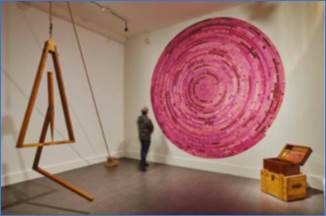
|
Figure 8 Kher Bharti (2020). VIRUS XI. [In A Consummate Joy, Virus XI is Accompanied by the Following Text Written by Kher, printed for the Viewer to Read and Take Home]. Installed at IMMA Dublin. Retrieved From: https://imma.ie/magazine/bharti-kher/ |
Virus XI is a reflection of the times we live in, where the world is constantly battling against infectious diseases. It is a reminder that viruses do not discriminate and can affect anyone, regardless of their background or social status. The artwork also serves as a symbol of hope, showcasing the resilience and strength of humanity in the face of adversity. Through its intricate details and vibrant colors, Virus XI captures the complexity and beauty of the microscopic world that surrounds us. It invites us to marvel at the wonders of science and to appreciate the power of art in conveying important messages. Ultimately, Virus XI encourages us to stay vigilant and work together towards a healthier future for all.
Generation X shapes politics additional actively across the globe. There will be a world oil crisis. Drones can patrol the skies. Texting will be made possible by thought power alone, using headsets that sight and convert brain signals to digital signals. A pill for curing malaria will be available, and major experiments in longevity can yield promising results.
Figure 9

|
Figure 9 Kher Bharti (2020). Gentle Bitch [Bindis on Smashed Mirrors 120 1/10 × 55 9/10 in | 305 × 142 cm] Retrieved From: https://www.artsy.net/artwork/bharti-kher-gentle-bitch |
Gentle Bitch is a provocative piece of art that speaks to the complexity of femininity. The use of bindis on smashed mirrors creates a stunning visual effect that draws the viewer in. The size of the piece, measuring 120 1/10 × 55 9/10 inches or 305 × 142 cm, adds to its impact and demands attention. The title, Gentle Bitch, is both intriguing and confrontational, challenging traditional notions of femininity and power. This artwork invites us to reflect on our own relationship with gender and identity, and how we navigate these concepts in our daily lives. It is a powerful reminder that femininity is not one-dimensional or easily defined, but rather a multifaceted and complex experience. Kher Bharti has created a masterpiece that speaks to the heart of what it means to be human - flawed, beautiful, and constantly evolving.
Right-wing ideologies notice a voice in leaderships across
the globe. The Climate crisis caused by changes in the weather and human folly
has become a severe threat to the world and its ecosystems. COVID-19 shuts down
the globe sparking the most important health crisis since the flu pandemic in
1918. Conspiracy theories, fake news, and left and right-wing voices clash on
the net. I’m out of the studio all year. I am 51.
6) Dhruvi Acharya
Mumbai-based artist Dhruvi Acharya, known for her
psychologically complex paintings based on personal experiences and events,
turned to watercolours to address the stress she, like many of us, feels
regarding the pandemic.
Figure 10
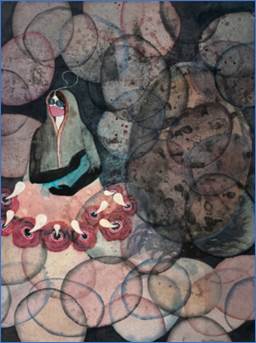
|
Figure 10 Acharya Dhruvi (2020). Painting in the Time of Corona. [Ink, Watercolour, Gouache on Paper]. Retrieved From: https://www.architecturaldigest.in/content/chemould-prescott-road-mumbai-open-sale/ |
The COVID-19 pandemic has affected every aspect of our
lives, including the way we create art. Acharya Dhruvi's painting, created
during this time of uncertainty and isolation, captures the essence of this
unique moment in history. The use of ink, watercolour, and gouache on paper
allows for a depth and complexity that reflects the complexity of our current
situation. The muted colours and soft lines convey a sense of introspection and
contemplation, as if the artist is reflecting on their own experiences during
this time. The painting also captures a sense of hope and resilience, with hints
of brighter colours peeking through the sombre tones. Overall, Acharya Dhruvi's
work is a testament to the power of art to capture the human experience in all
its complexities, even in times of crisis.
Dhruvi has found her solace during this time, and it is
beautiful to visualise how attractively she has chosen her medium to find
refuge and peace in the world’s chaos.
Figure 11
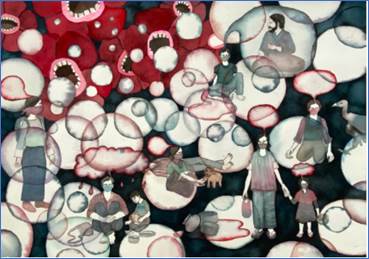
|
Figure 11 Acharya Dhruvi (2020). Painting in the Time of Corona. [Watercolour on Paper]. Retrieved From: https://www.architecturaldigest.in/content/chemould-prescott-road-mumbai-open-sale/ |
The pandemic has brought about many changes in our lives,
and Acharya Dhruvi's painting perfectly captures the essence of this time. The
watercolour on paper depicts a world that is both familiar and yet completely
different. The colours are muted, as if reflecting the subdued mood of the
times. There is a sense of isolation and loneliness that pervades the painting,
as if we are all trapped in our own little bubbles. But there is also a glimmer
of hope, represented by the bright yellow sun in the background. It reminds us
that even in these dark times, there is still light to be found. The brushstrokes
are loose and free, as if to suggest that even though we may feel constrained
by the circumstances, our creativity can still soar. Overall, Acharya Dhruvi's
painting is a beautiful representation of this unique moment in history and a
testament to the resilience of the human spirit.
The covert girl in Dhruvi Acharya’s painting seems to be cradling a seal-like creature in its arms as wailing mouths lie scattered at her feet. There are square murky measure circles floating all around. At this work, notice each tragedy and hope. It speaks to our knowledge with power and truth.
7) Atul Bhalla
Delhi-based artist Atul Bhalla has discovered some surprising facts concerning the lapses within the country’s capital urban water distribution system. Bhalla's work is characterised by a deep exploration of the relationship between humans and nature. His art often features a combination of photography, sculpture, and installation, creating immersive environments that encourage viewers to contemplate their own connection to the natural world. Bhalla's compositions are carefully crafted, with each element thoughtfully placed to create a sense of balance and harmony. His use of colour is also notable, with earthy tones and natural hues dominating his palette.
Figure 12
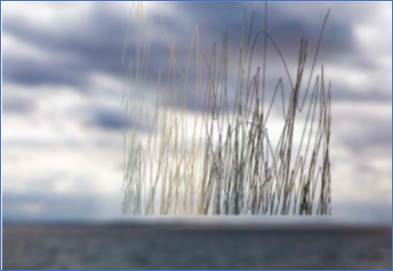
|
Figure 12 Bhalla Atul (2020). The River Runs in Me – II. [Archival Pigment Print]. Cornell University, South Asia Program. Retrieved From: https://www.sepiaeye.com/atul-bhalla-news |
In "The River Runs in Me - II," Bhalla Atul captures the essence of a flowing river through his archival pigment print. The image is a stunning portrayal of the movement and energy of water as it courses through the landscape. The intricate details and textures of the riverbed are brought to life, while the rippling surface of the water creates a sense of depth and motion. Atul's use of color and light further enhances the beauty of this natural wonder, as shades of blue and green blend together to create a serene and calming atmosphere. Through this work, Atul reminds us of the power and importance of nature in our lives, and encourages us to appreciate its beauty and majesty.
Figure 13
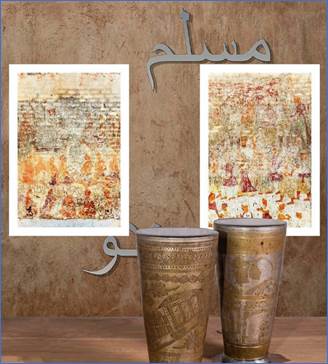
|
Figure 13 Bhalla Atul (2020). Which Glass Did They all Drink From? [installation]. The Partition Museum, Town Hall, Amritsar. |
In light of the Freedom Struggle, Partition,
and events in Punjab, Atul Bhalla investigates the connections between memory,
post memory, and truth. He examines the politics of water sharing, rivers, and
borders using water as a metaphor. In order to
highlight the obscurity, denial, and untruth surrounding India's relationship
with significant events like Partition, the work examines the idea of truth
within the Punjabi identity.
8) Jiten Thukral & Sumir Tagra
Jiten Thukral and Sumir Tagra's artwork, art style, and philosophy
are a unique blend of pop culture, traditional Indian art, and contemporary
aesthetics. Their works are a celebration of the everyday and the mundane,
infused with humour and wit. Thukral & Tagra's art style is characterised
by bold colours, graphic patterns, and playful imagery that reflects their
interest in design and fashion. Their philosophy is rooted in the ideas of
collaboration and community, as they often work with local artisans and
craftsmen to create their pieces. They believe that art should be accessible to
everyone, not just the elite few, which is why they often incorporate everyday
objects into their works. Thukral & Tagra's art has been exhibited in
galleries around the world, including New York, London, and Mumbai. Their work
has also been featured in numerous publications, such as Artforum
and The New York Times. Overall, Thukral & Tagra's artwork is a testament
to the power of creativity to bridge cultural divides and bring people together
through shared experiences.
Figure 14

|
Figure 14 Thukral & Tagra (2020). Dominus Aeris Coleus Xiv. Nature Morte and Vadhera Art Gallery, New Delhi, India. Retrieved From: https://www.architecturaldigest.in/content/online-exhibition-show-offers-glimpse-into-human-minds-coronavirus-pandemic/ |
(Here's Why You Must Not Miss Future Is Not Fixed, an
Exhibition by Nature Morte and Vadehra Art Gallery,
Curated by Arjun Sawhney - ELLE DECOR, 2020c) Bhadri (2020)
Thukral & Tagra's art style in their work "Dominus
Aeris Coleus Xiv" is characterised by bold
colours, clean lines, and a mix of graphic design and traditional painting techniques.
Their use of vibrant hues and geometric shapes creates a sense of energy and
movement within the piece, while their attention to detail adds a layer of
depth and meaning to the overall composition. Overall, their unique style
blends contemporary aesthetics with traditional forms to create something
entirely new and exciting.
Figure 15

|
Figure 15 Thukral and Tagra (2020). The Sundry Effect. Bikaner House, New Delhi. Retrieved From: https://www.thukralandtagra.com/the-sundry-effect/ |
This particular aspect of the
farmer's fate—a life that hangs in the balance—is highlighted by the exhibition
"Farmer is Wrestler." It addresses the pressing agrarian crisis that
Indian farmers are currently experiencing. The lives and livelihoods of Indian
farmers have been severely impacted over time by generational land disputes,
climate change, vote-bank politics, a lack of legal enforcement, and a general
lack of formal education in rural areas.
Thukral & Tagra illustrate a civilisation lacking any
signs of life, drifting in a very mire of stasis, failure, and suspended time.
Thus far away from the real world, the palette heightens the startling
implications.
9) Sameer Kulavoor
Sameer Kulavoor's artwork is a true testament to his unique and innovative style. His pieces are characterized by their bold use of color, intricate detailing, and striking imagery. Whether he is working with paint, ink, or digital media, Kulavoor always manages to capture the essence of his subject matter in a way that is both captivating and thought-provoking. His work often explores themes of identity, culture, and social commentary, challenging viewers to question their own perceptions of the world around them. From his stunning portraits to his abstract landscapes, each piece in Kulavoor's collection is a masterpiece in its own right. With a keen eye for detail and an unwavering commitment to excellence, Sameer Kulavoor has established himself as one of the most talented artists of his generation.
Figure 16
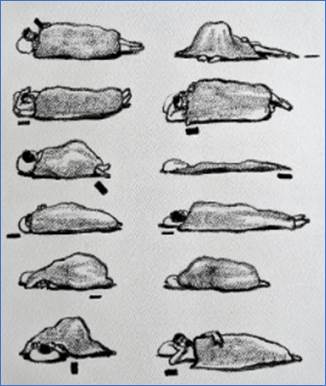
|
Figure 16 Kulavoor Sameer (2020). Psycho-Somatic. [Solid Marker on Paper, Drawing]. Online. Retrieved From https://lifestyle.livemint.com/how-to-lounge/art-culture/sameer-kulavoor-s-new-show-investigates-the-way-we-view-the-world-through-a-screen-111606901504160.html. (Art India (2020) |
This is a screen-printed smartphone-sized zine containing a series of drawings created with solid marker on ‘Claire Fontaine Acid-Free’ rough-textured paper on the 30th of May 2020 in Mumbai throughout the COVID-19 lockdown. It is based on the psycho-somatic restlessness caused by constant exposure to (mostly bad) news on the market at our fingertips.
Figure 17

|
Figure 17 Kulavoor Sameer (2020). Dysfunctional 2 [Acrylic and Watercolours on Paper, 11.5 X 8.3 Inches] |
The artwork Dysfunctional 2 by Kulavoor Sameer is a stunning piece that showcases the artist's talent and creativity. The use of acrylic and watercolours on paper creates a unique texture and depth to the painting, making it stand out from other works of art. The size of the painting, 11.5 X 8.3 inches, adds to its charm, as it is small enough to be displayed in any room yet large enough to make an impact. The title Dysfunctional 2 adds an element of mystery and intrigue to the painting, leaving viewers wondering about its meaning and significance. Overall, Kulavoor Sameer's Dysfunctional 2 is a beautiful work of art that deserves recognition for its originality and artistic merit.
3. METHODOLOGY
This paper is based on a study of literature reviews, journals, online searches, online galleries, India Art Fair 2020, magazines, and articles as secondary data.
4. DISCUSSION
The past year has been more than a little unrestrained, with
myriad crises encompassing the world pandemic and social and political ruptures
fixing nearly every side of the lifestyle.
Figure 18
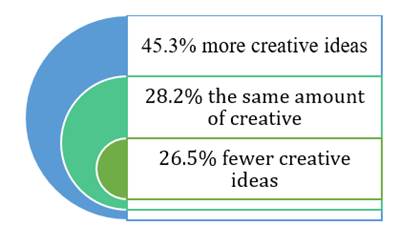
|
Figure 18 Source A World Survey on the Creative Industry During Covid-19 – Quartz at Work |
The art world has been affected in due course, with a way of
flux palpable in museums, galleries, biennials, fairs, auction houses, and
places where artists live and work. Remember, on a year that sounds like it
lasted a great deal longer than twelve months, the artwork above is the most
influential of 2020.
‘Lockdown is for the people, not for creativity and
imagination’ – insights on resilience from the Chitra Santhe
artists.
The COVID-19 pandemic has had a profound impact on the art world, and Jitish Kallat is no exception. A comparative study of his work during this time reveals a shift in his focus towards themes of isolation, connection, and hope. Kallat's use of mixed media has become more pronounced, as he incorporates found objects and materials into his pieces to reflect the uncertainty and chaos of the pandemic. His use of color has also evolved, with brighter hues reflecting a sense of optimism amidst the darkness. Kallat's work during COVID-19 has been marked by a sense of urgency and introspection, as he grapples with the challenges facing society at large. Despite the difficulties presented by the pandemic, Kallat's art remains a powerful testament to the resilience and creativity of human beings in times of crisis.
The pandemic has brought about significant changes in the art
world, with artists having to adapt to new ways of creating and exhibiting
their work. Atul Dodiya, known for his mixed media works, has continued to
explore themes of cultural identity and politics through his art. Nalani
Malani, on the other hand, has shifted her focus towards more introspective
works that reflect on the human condition during these uncertain times. Asim
Waqif, a sculptor and installation artist, has created works that address issues
of urbanisation and environmental degradation. Bharti Kher's mixed media works
continue to explore themes of gender and identity, while Dhruvi Acharya's
paintings reflect on the emotional impact of the pandemic. Atul Bhalla's
photography focuses on the relationship between humans and nature, while
Thukral & Tagra's multimedia works explore themes of consumerism and
popular culture. Sameer Kul's paintings reflect on the impact of COVID-19 on society as a whole.
5. CONCLUSION
The paper assembles images, meditations, and philosophical positions these fraught times have triggered. A collection of photos provides a window into the minds of artists, a flurry of unsettling thoughts and the demons they battle. It is a brief record of the uneasy serenity they seek and the agony they feel amid a crisis that evolves into new forms with each passing week.
Art, literature, and music are the most effective lift support systems in these times of crisis. They provide us with lasting hope; they introduce us to different kinds of brightness; they help us connect with our inner powers.
Art provides clues to decode the way ahead even as it heals.
CONFLICT OF INTERESTS
None.
ACKNOWLEDGMENTS
None.
Art India. (2020). The Art News Magazine of India, Art in the Time of the Coronavirus,
Quarter 2, 24(1).
Barbara, S. (2020). These Artists have Found Creative Ways to Offer Hope Amid the COVID-19 Crisis. World Economic Forum.
Bhadri, A. (2020 September 10). Here’s why you Must not Miss Future is Not Fixed, an Exhibition by Nature Morte and Vadehra Art Gallery, Curated by Arjun Sawhney. Elle Décor.
Nair, U. (2020). Artist Jitish Kallat Marks the Passage of Time in à Brand-New Series of Drawings (August 14, 2020). Nature Morte.
The Defining Artworks of 2020 (2020 December 9). Artnews.com.
|
|
 This work is licensed under a: Creative Commons Attribution 4.0 International License
This work is licensed under a: Creative Commons Attribution 4.0 International License
© ShodhKosh 2023. All Rights Reserved.

